Fri 14 Nov 2014
Astrogeek Funnies
Posted by anaglyph under In The News, Laughs, Photography, Robots, Science, Technology
[2] Comments
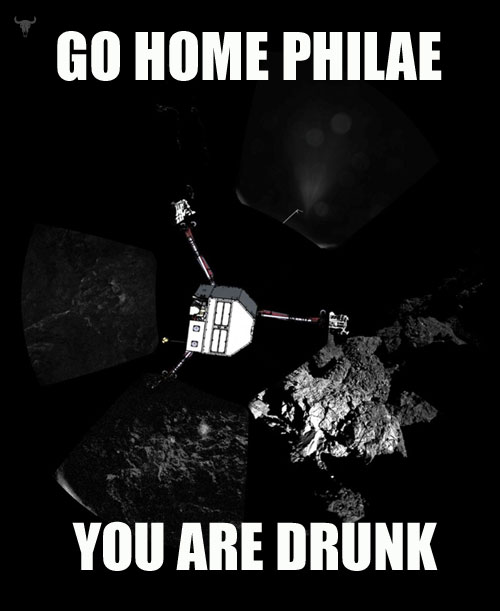
Fri 14 Nov 2014
Posted by anaglyph under In The News, Laughs, Photography, Robots, Science, Technology
[2] Comments

Sun 15 Dec 2013
Posted by anaglyph under In The News, Robots, Science, Space, Technology
[12] Comments
Sat 23 Feb 2013
Posted by anaglyph under DIY, Gadgets, Geek, Music, Robots, Science, Sound, Technology, Work
[6] Comments
So at last, my mysterious project is complete.
You saw Laura a couple of days ago as she arrived, straight out of the box. She was not quite as perfect as I would have liked, so the first step involved some surgery…
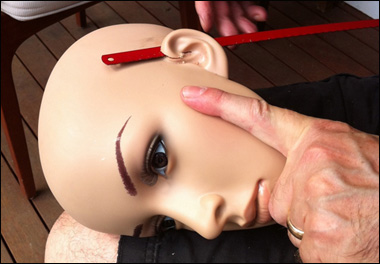
As did the second step. ‘Trust me Laura,’ I said ‘I’m a doctor’. Well, I’m a Reverend, and that’s as good as, right? I mean, with God the Cow on my side, how can I do wrong? A little release of intracranial pressure…
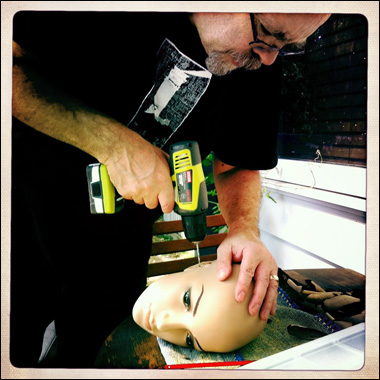
Ah, that’s better. And now for the pièce de résistance… And Binauralaura (Laura to her friends) is ready to begin to listen…
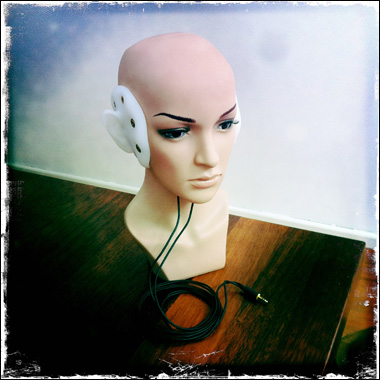
Binauralaura is my new binaural recording rig. Here begins the edumacation part of this post, so those who came for the titillation can now go watch Fox news and eat donuts.
To start, you should know that when you hear a stereo recording of sound or music – pretty much any recording – it is presented to your ear in a very different way to the way in which you actually hear in reality. There are many reasons for this, but the main one is that most sound recordings, and most music recordings in particular, use a somewhat artificial method to render their stereophonic sonic landscape. In a standard electronically-reproduced stereo domain, the stereo image is created from two point sources – your two hifi speakers, or two headphone speakers – each of which is fed by a discrete channel of recorded sound. All sound in a stereo field is thus contained in two separate, but interconnected, recordings – one for left and one for right. In simple terms, if a sound is only in the left channel, it will appear to come from your left. If it is only in the right channel, it will appear to come from your right. In almost all modern recordings, when an engineer wishes to make a sound feel like it is originating elsewhere in the stereo image – slightly left of centre, for instance – it is made slightly louder in the left channel than it is in the right. To make it appear to be right in front of you – or ‘centre’ as we say – then the volume is made exactly equal for both the left and the right channels. For over half a century, this result has been achieved by ‘panning’ the sound on a mixing console. A panner is simply a control that varies the amount of signal (or loudness) added to each channel.
In the real world, though, our ears don’t judge the position of a sound in space solely by its loudness. Certainly, loudness is one aspect of the mechanism, but there are numerous other factors in play. The principal one is a component of time. If you hear a dog barking somewhere ahead of you, and slightly to the left, one of your ears will be receiving a slightly greater sound pressure (loudness) than the other. But crucially, that same ear will be hearing the sound very slightly before your other ear does. The human brain can, in fact, differentiate time differences smaller than 10 microseconds between your two ears, and it is that ability which allows us to aurally locate objects in space with an accuracy of about 1 degree. ((It’s more accurate if the sound is in front of you. As it approaches the extreme sides, the ability to pinpoint its location decreases.)) ((As an aside, there is a species of fly which is so small that its ears are too close together for its head to have any effect on time delays between them. Instead, it has evolved an entirely different and novel way of localizing sound. The trick it uses (its ears are physically coupled together, allowing it to detect sub-microsecond delays) is currently being explored as a possible microphonic technique.)) Up until very recently, this time component could not be easily recreated in a studio mixing environment, and since – like most things – the recording process is a trade-off between the achievement of perfection and economic imperative, the old panning paradigm is still alive and well (and dominant) in modern sound mixing facilities. I would make a rough guess that 99.9% of all music and sound you hear is rendered to stereo with crude analogue panning.
Now, some of you may be ahead of me slightly here, and interject: ‘But Reverend, what about a recording made solely with two microphones? There’s no mixing console involved there (so no artificial panning) and the sound of any object off centre to the microphones must arrive at slightly different times for each? Surely that’s preserved in a recording?’
Well, yes indeed. Two separate microphones (or a coincident stereo pair, to use the lingo) will indeed preserve the delay times inherent in the scene being recorded but they still don’t hear the world like our ears do.
The important thing to understand at this point is that when it comes to human hearing, our eardrums – our ‘microphones’ if you like – are only part of the story. There are several other key players in the process, the most important of which is our brain. Our brain and ears work together to ‘hear’ the world, and the way we hear is a lot more complex and clever than you probably ever stopped to think about.
One thing that every one of us knows (because our brain figures it out pretty much as soon as we are born) is that our ears are separated from one another by a head. Everything we experience in the realm of natural hearing is mitigated by this big noggin right in the middle of things. And our brain calculates our aural experience by taking it into account as it forms our sonic picture of the world. Likewise, we are accustomed to hearing our surroundings via two fleshy reflectors that funnel the sound toward the vibrating membranes that actually detect the sound waves. The complicated contours of our ears – the pinnae – don’t simply look like they do for decoration. The whorls and cavities of the ear surface impose certain kinds of characteristics on the sound that reaches them, and these help us with sound localisation, and, to a certain extent, with the perception of fidelity.
Which brings me all the way back to Binauralaura. Laura’s head contains a pair of high fidelity omnidirectional microphones that sit in her ears just at about the place where the outside part of the human ear canal would start. ((Not where the ear drums are – there’s a technical reason for this that I won’t go into here, but there are versions of binaural heads that do place the microphones right at the end of the ear canal.))
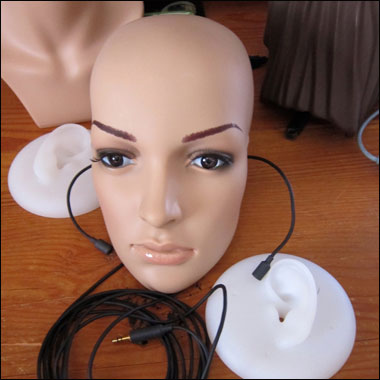
Her silicon pinnae are created from a CT scan of real human ears and these and her head create an aural ‘shadow’ which will match, in a generic way, the listening field of most humans. ((It probably has occurred to you that most humans have small differences in the shapes and sizes of their ears. Shouldn’t this mean that one person hears differently to another? Well, yes, that’s right. To make a really convincing binaural recording for yourself, you would ideally put microphones in your own ears, and record with your own pinnae and head shape. Indeed, there are methods for doing this. To me, it does seem rather sonically masturbatory, though…)) This means that a recording made with Binauralaura, will sound about as real as an audio recording can sound. ((There are numerous other impediments to capturing a sound recording that would appear as real as reality. Mostly this has to do with the way our brain constantly interacts with the environment – not just the sound itself – to modify what we hear. And, in fact, what we think we hear is nothing like what we physcially hear. This problem is never really likely to ba addressed with a mechanical recording system. Until we have some kind of direct ‘neural recorder’ you can never really expect to experience a sound recording that is like really hearing something.))
So if binaural recording is so magnificent, why isn’t it used for everything? Well, there is, of course, a catch. The binaural effect can only properly be discerned by wearing headphones. For the binaural image to remain coherent, the sound for one ear must not interfere with the sound for the other. Additionally, in order to avoid a doubling of the head and pinnae shadow (one gained from the recording, and then a second from the listener’s own head and pinnae), the reproduced sound needs to be played back as close to the listener’s ear canal entrance as possible. The most expedient method to do this is via headphones or earbuds. ((There are ways of achieving a serviceable binaural illusion in stereo speaker systems, but they are expensive, dependent on room acoustics, and require the listener to sit in a ‘sweet’ spot. Needless to say, all this is even less appealing than wearing headphones.)) Wearing headphones to properly hear binaural sound is, in fact, analogous to the requirement to wear glasses to see 3D images (indeed, binaural sound is often described as ‘3D’ or ‘holophonic’ sound).
I’ve had some opportunities to take Laura out for a bit of a test spin, and so far, the results are pretty nice. Here’s a short clip. Remember – wear headphones or earbuds to listen to it. One thing you will immediately notice is the clarity and and detail of the sound space. If your hearing is fair, you may also detect one of the extraordinary features of binaural sound – something you will not hear in a conventional stereophonic recording – and that is the ability to localise sound height. Have a listen now, and see why I went to all the trouble to build Binauralaura.
Download Laura Listens
Sun 17 Feb 2013
Posted by anaglyph under DIY, Gadgets, Geek, Hmmm..., Science, Sound, Technology, Work
[13] Comments

This is my new assistant. I am about to augment her for my secret project. Hint: she is not a Roman.
Wed 13 Feb 2013
Posted by anaglyph under Gadgets, Geek, Sound, Technology
[12] Comments

This is what I got in the mail yesterday. I figured that as one gets older, it’s de rigeuer to enhance one’s best assetts with silicone, right?
Heh. Just kidding. I have a project. It should be interesting. I’ll tell you all about it as I go.
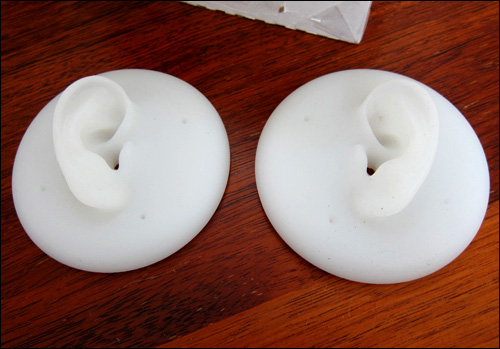
Mon 3 Sep 2012
Posted by anaglyph under In The News, Numbers, Philosophy, Politics, Science, Skeptical Thinking, Space, Technology
[26] Comments
While Violet Towne and I were out on our bikes yesterday, our conversation turned to philosophy and politics, as it sometimes does. Specifically, I was defending the Mars Lab/Curiosity program against her assertion that it was a waste of money when there were so many much more important issues on the political plate. Well, I agree that there are numerous pressing matters that need our attention (and money) but I was most vehement that there are a lot of other things that could lose a few pounds (metaphorically speaking) before we should start carving up great and inspiring science projects.
“For instance,” I said, “Do you realise that the 2012 Olympics cost more than twice as much as Curiosity? And that the US bank bailout was more than ten times the budget of the Mars Science Lab mission?”
I don’t think she believed me.
“Show me the numbers!” she said, defiantly.
Well, Acowlytes, you all know it’s best not to challenge the Reverend when he’s on his soapbox, even if you’re the Reverend’s wife. ((You’d’ve thought she would have figured this one out by now…)) When we had pedalled homewards, I went straight to Captain Google, and plugged in my questions. You might understand, dear Cowpokes, my utter amazement when I found my figures were wrong. Wrong by an order of magnitude. But not in the direction VT had hoped. It’s FAR worse than I had even imagined. Here ya go. I made a graph:
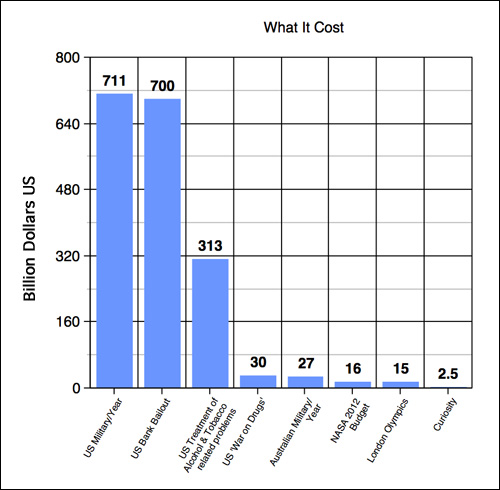
As you can plainly see, the budget for the Curiosity/Science Lab project is not even one pixel high on this comparison scale.
So, in order to get some perspective on how much that little rover trundling around on the surface of Mars costs, let’s examine some of those figures and related issues. First of all, it’s obvious that the military budget for the US for one year (2012) and the amount of money spent on the bank bailout are each in a completely different league to the kind of expense put aside for Curiosity. It isn’t hard to see that even NASA’s entire budget for 2012 is hardly a blip on the radar for the government accountants when compared to sums like that. What’s even more gobsmacking is that each of these figures (that is, ONE SINGLE YEAR of US military spending, or the humoungous pile of money forked out to save the US economy from the destruction wrought by the excesses of greedy and morally reprehensible assholes) exceeds the budget of NASA’s entire 50 year existence. ((Here. Do the sums.)) The yearly outlay for military air-conditioning alone exceeds NASA’s annual budget by 4 billion dollars. ((The Pentagon rejects this figure, which was calculated by Brigadier General Steven Anderson, a military logician for operations in Iraq. They have, however, not put forward an alternative anywhere I could find. I’m open to correction on this.))
The London Olympics cost, in fact, nearly 6 times more than Curiosity – not merely double as I’d thought – and we’re only talking about the money spent to stage the games. ((Arguably, some of that expense is recouped in benefits of one kind of another by the British taxpayers, but not the majority of it by any means. Equally as arguably, the Mars Science Lab program has benefits of one kind or another for the human race.)) It’s plain that large amounts are poured into the Olympics from elsewhere as well, including every participating nation’s competition expenses, and not insubstantial amounts from all the bids made by countries attempting to secure the Games every four years. That’s a frikkin’ ginormous pile of cash for a sporting event. Even if you amortize the London expense over 4 years, the yearly figure still exceeds that of the Mars Science Lab mission. Of course if we permit that, it should be fair to amortize Curiosity’s cost over the Mars Science Lab program’s lifetime (9 years), making the contrast even greater and returning an expense to the US taxpayers of $277m per year (or, less than a dollar per person per year). For 2012/13 the Australian government has budgeted over 10 times that figure for sport. ((I had trouble finding out how much the US government spends on sport. It’s either a well kept secret, or they don’t care to support the same ridiculous level of sports fantaticism as ours does.))
To put that per-person/per-dollar/per-year expense into perspective, Americans ((Canadians are also included in this figure, but even cutting it by, say, a generous third, that’s still a shitload of money.)) spent 4 times the cost of the Curiosity mission at the cinema in 2010 ((I couldn’t find anything more recent, but I think it’s safe to say that 2011 & 2011 will track that figure.)), and are spending something like $137 billion dollars a year on alcohol ((2002 figures, but I think we can probably assume that has trended upwards rather than down.)) and somewhere in excess of 30 billion dollars a year on cigarettes. In 2011, the US government spent 313 billion dollars ((This is probably a conservative estimate – it’s hard to get an exact figure due to the nature of defining the field, but I’m quoting on the conservative side. Stats here and here.)) on ameliorating the problems caused by the abuse of all that alcohol & tobacco. And, while we’re on the subject of substance abuse, coming in at a staggering 30 billion dollars, ((Depending who you ask. It’s variously quoted at somewhere between 20 and 40 billion. It’s certainly not less than 20, but it may be more than 40. In any case, I’ve erred on the probable side of conservatism and just taken the median.)) America’s so-called ‘War on Drugs’ costs the nation over 10 times the budget of Curiosity (or, nearly twice the annual NASA budget) every year and that is widely argued to be a complete waste of money. ((Here, here, and here, for just three examples of hundreds you can find.))
I could, of course keep going with this – I haven’t touched on gambling, or government inefficiency, or tax breaks for religion or a half dozen other areas where large amounts of money seem to slush around without a proper degree of scrutiny. But what does all this mean, in the end?
For me, it’s simple. As humans we can, of course, choose to put our resources wherever we like. So far, I believe that choice has always leaned far too heavily towards the things at which animals are good – being the fittest, the strongest, the fastest. Or being the greediest, the most aggressive, the most dominant. It has not served us well. The result is that we have become powerful animals facing an existential crisis, and the traits that we carry as animals – the aggression, the greed, the power-mongering – are the exact opposite of what we need to get us out of this crisis. We are starting to encounter problems that we will not conquer by being fast, or strong or fit. ((Or religious.)) Being better at animal things was once enough. Now it isn’t.
The things that humans alone are good at – the things that our brains enable us to do such as imagining the possibilities of the future, pondering the poetry of our existence, turning our curious gaze onto the mechanics of the very universe itself – occupy the very tiniest parts of the minds of most people (and therefore most governments). This ability that humans have to plan for the future by creating a mental vision of it is more-or-less nonexistant in all other animals. ((To all intents and purposes it is completely non-existant as far as we know, but that’s an area of research that is still contentious.)) So what do we do to the people who are very good at this kind of inspirational far-thinking? We vilify and undervalue them. When they tell us ‘There is a big problem with the climate and we should do something about it!’ the powerful apes get up on their boxes and beat their chests, so that they might remain popular and powerful, and the greedy apes use all the cunning that their superior brain has given them to make arguments that everything is OK and we should all just kick back and consume, and the fit and fast apes run around entertaining everyone. If we cannot use the leverage that nature has given us to come to terms with the world-destroying problems we now face, we are truly doomed. We have squandered the one advantage that we have over other animals. Our difference will have enabled us to wipe ourselves out, rather than allowed us to achieve that future which we alone can imagine.
So what has all this to do with a little vehicle pottering around in the dust of a cold world some 225 million kilometers from our home? Well, in my opinion, projects like Curiosity help us turn our gaze outward – out of ourselves and away from our tiny little human preocupations. Indeed, I think that this curiosity to know stuff that has no direct consequence to our animal existence is a marker that says that we may, perhaps, have a chance after all.
There are, of course, many areas where we might have directed the 2.5 billion dollars that went to Curiosity. Violet Towne considered that it would have been better spent going towards helping solve the climate change problem, for example. Well, I agree that climate change research is an area that could really use that kind of money. And there are numerous pressing compassionate issues that are desperately in need of money also. I hope my argument has convinced you (and her), though, that stealing the funds from visionary human endeavours like the Mars Science Lab is entirely the wrong tactic if you want to help address these probems. I want to make it quite clear that I’m not advocating doing away with sport, or stopping everyone from imbibing reality-altering substances, or even saying that we could conveniently curtail all our military spending, but to me it seems that all these pursuits – these profoundly ‘ape-like’ pursuits – are where we should look first for money that could be better off spent elsewhere. I’m pretty sure they could spare a little of the quite exorbitant amounts of cash that are currently rained down on them.
___________________________________________________________________________
Violet Towne fears that I have portrayed her as a Luddite here, and as somewhat anti-science. I want to assure you that she is not, and that I respect her views, and her willingness to challenge me on my own, very much. You all know that it’s unlikely I would last long with a partner who didn’t have a vibrant and informed worldview. But I think I am right in saying that, like many people, she had formed an opinion – almost entirely concocted by irresponsible and ignorant media reporting, in my view – that NASA spends excessive amounts of money on things no-one really cares about. My intent with this post is simply to demonstrate that, in the grand scheme of things, NASA’s budget is relatively well spent. It seems to me that robbing Peter to pay Paul by redistributing NASA’s budget to areas of more pressing need is a kind of madness fanned by a perplexing and distressing anti-science sentiment creeping across the world.